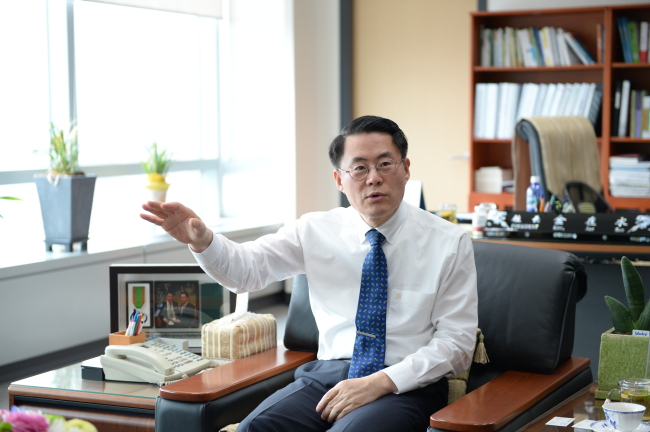[Herald Interview] Agricultural exports need stronger R&D, coherent hansik branding: aT chief
State-run agro-food agency chief urges manufacturers to develop killer products and reduce dependence on government subsidies
By Chung Joo-wonPublished : May 25, 2015 - 19:40
The Korea-China free trade agreement to be formally signed later this year, provides an opportunity for Korean food products to expand into the world’s second largest economy, said the head of the state-run agency to promote agro-food products.
“I am confident that food can form a market as huge as electronic devices and automobiles, not to mention its scope for speedy growth,” Kim Jae-soo, president and chief executive of Korea Agro-Fisheries and Food Trade Corp., or aT, said in an interview with The Korea Herald last week.
“The domestic food market has been suffering from chronic oversupply and price drops, and government subsidy is not a sustainable way for raising competitiveness,” said Kim, who served as vice agriculture minister and head of the Rural Development Administration.
“I am confident that food can form a market as huge as electronic devices and automobiles, not to mention its scope for speedy growth,” Kim Jae-soo, president and chief executive of Korea Agro-Fisheries and Food Trade Corp., or aT, said in an interview with The Korea Herald last week.
“The domestic food market has been suffering from chronic oversupply and price drops, and government subsidy is not a sustainable way for raising competitiveness,” said Kim, who served as vice agriculture minister and head of the Rural Development Administration.

“It is time for Korea to become a strong exporter of food products,” he stressed, calling on the domestic agro-food exporters to develop “killer products” that have no substitute in China.
To boost the market competitiveness of Korean agricultural exports, the aT CEO underscored the key agendas, including competitive R&D, decent branding of Korean cuisine and fostering of the young talents from diverse fields.
“Successful exports do not come for free, and some even say that government subsidies to loss-making businesses make them even more uncompetitive,” Kim said, stressing the significance of the industry’s active R&D. The longtime agricultural policy expert implied that government subsidy should not backfire on agro-food industries, shutting down healthy market competition.
Looking back at some past lessons from Korean exports to Japan, he admitted that some SME agro-food exporters, including some traditional liquor makers, ended up with a short-lived ethnic fad in Japan, because they neglected the core R&D for product differentiation and meeting consumer needs. Instead they turned to the government for help to make up their losses.
“Many of them only resized and repackaged the same or similar products and called it ‘product diversification.’ But they really should have pushed for extensive R&D. For instance, ‘how to extend the expiration date of those easily-soured fermented drinks, or what certain flavors the market likes and dislikes.”
In the same context, Kim recalled visiting an old traditional brewery of makgeolli ― milky liquor made from fermented rice ― accompanied by some business consultants and academicians. With due respect to the brewer’s artisanship, the visiting experts gave the brewer some professional feedback for the production procedures and preparations for export, but they were too stubborn to listen to the third-party views, Kim added.
According to government data, the annual foreign orders of makgeolli fell to $15.4 million last year, down 81.1 percent from $52.7 million in 2011, as the key importer Japan shunned the product.
In addition to invigorating R&D, the aT chief noted the significance of coherently decent branding of Korean cuisine.
“Quality and brand power rules the food market these days, unlike in the earlier hunger-driven days (in the aftermath of the 1950-1953 Korean War)” Kim said.
Pointing to the impact of global branding of Korean cuisine, or “hansik,” Kim said Korea needs a coherent, desirable and unified brand of Korean restaurants around the world.
“Besides the recipe, the hansik settings are important for its proper globalization,” he said. Serving hansik with plastic wares on plastic tables, for example, may not affect the taste but may undermine the global image of the cuisine in the long term, he added.
Kim took Thailand’s Global Thai Restaurant project ― a Thai government-led campaign to boost the Thai cuisine to the top level globally ― as a positive example.
The so-called GTR project formulates specific rules on the settings, ingredients and others to launch “a McDonald’s of Thai food” that not only sells savory Thai food but also promotes the nation’s cuisine and its delicate cultural ambience.
“It may take time to make the world familiar with Korean food. They may try hansik out of curiosity at first. But the world began to recognize the great nutritional benefits of kimchi and other Korean dishes, as we see in the successful export of Korean seaweed to the United States.”
Last year, the export of Korean seaweed, or “gim,” hit $274 million to around 90 countries, and shone as a rare jackpot item in the U.S. market. Kim attributed gim’s success to the world’s familiarity of Asian seaweed products, the global healthy food trend and Korea’s fervent R&D on gim on the U.S. soil.
“Boosting global demand for Korean agro-food and hansik needs time and effort, just as any manufactured goods. The foreign exporters did the same for their bread and coffee, so why should not we?” Kim confided.
By Chung Joo-won (joowonc@heraldcorp.com)




![[Herald Interview] 'Amid aging population, Korea to invite more young professionals from overseas'](http://res.heraldm.com/phpwas/restmb_idxmake.php?idx=644&simg=/content/image/2024/04/24/20240424050844_0.jpg&u=20240424200058)







![[Hello India] Hyundai Motor vows to boost 'clean mobility' in India](http://res.heraldm.com/phpwas/restmb_idxmake.php?idx=644&simg=/content/image/2024/04/25/20240425050672_0.jpg&u=)





![[Today’s K-pop] NewJeans' single teasers release amid intrigue](http://res.heraldm.com/phpwas/restmb_idxmake.php?idx=642&simg=/content/image/2024/04/26/20240426050575_0.jpg&u=)